The North Face Vectiv Pro is the brand’s first and only landmark carbon-plated ultra-distance trail running shoe. It sits at the heart of the Vectiv range and is designed with loads of input from TNF's ultra athletes, who we love to occasionally interview.
Unlike other models in The North Face’s trail range – like the Enduris 4, which offers solid, supportive cushioning with a less aggressive rocker and does double duty as a decent hiking shoe, or the Offtrail TR, with its big, spiky lugs and waterproof upper for fell running – the Vectiv Pro is built for one thing: fast, long-distance racing on the trail.
Famously championed by ultrarunner and podium-regular Elsey Davis, the Pro's whole approach is to sacrifice a bit of technical agility and close-to-the-ground feel in exchange for a level of speed, cushioning and long-distance comfort that’s unrivalled by even the very best trail running shoes.
I was a huge fan of the original Vectiv Pro shoe – it's insanely propulsive and surprisingly water resistant. Then, when reviewing the Pro 2, our team agreed that we were seeing some subtle but overall small-potatoes improvements.
But the Vectiv Pro 3 feels like a much bigger step forward. With a substantial increase in stack height from 32mm to a whopping 43mm in the heel, a reshaped midsole, a new Dream Foam insert underfoot and a sharper, more aggressive outsole design, the Pro 3 clearly still has ultra-distance racing in its sights. Only now, it’s leaning even harder into plush cushioning and forward propulsion, while stepping further away from proprioceptive trail feel.
Let’s dive in and take a closer look.
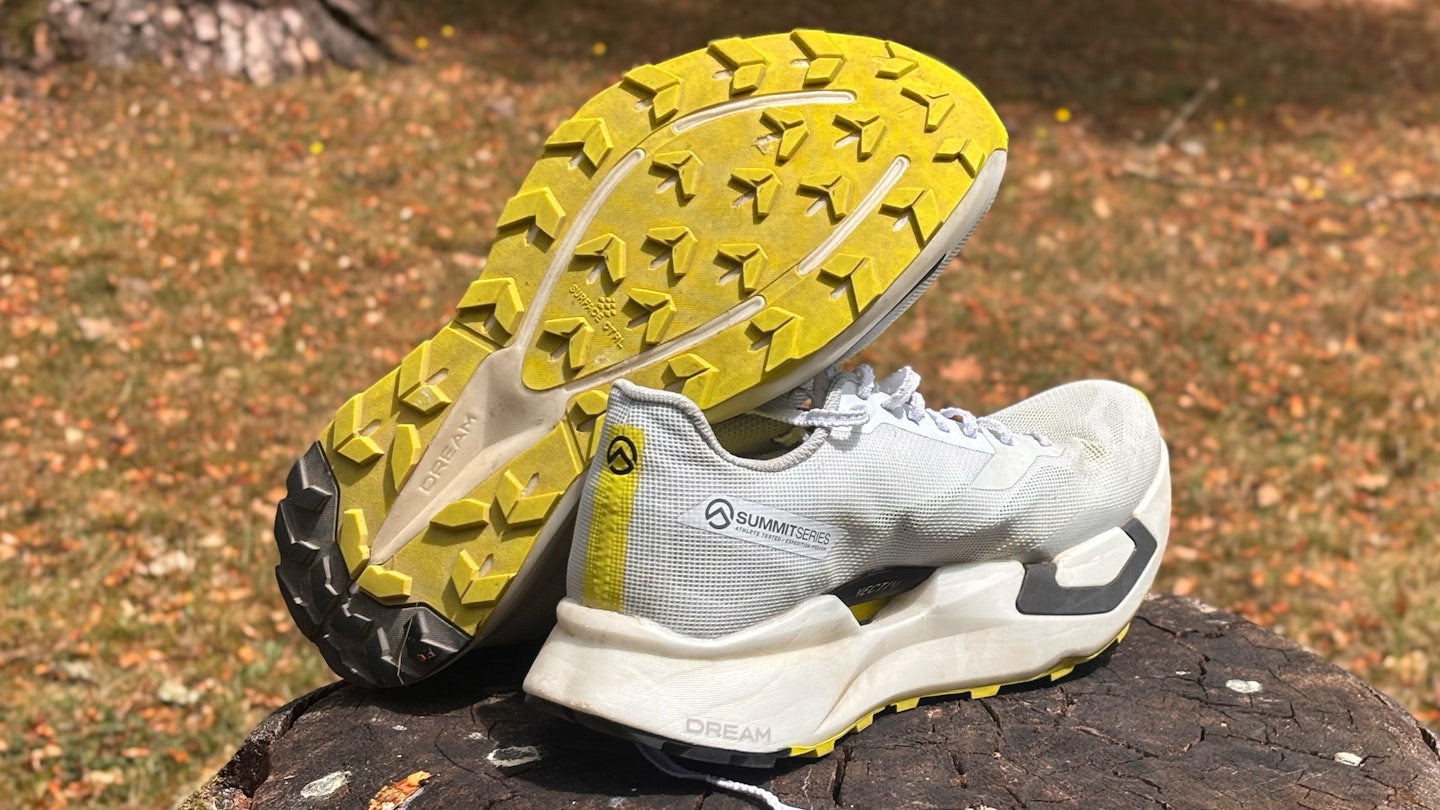 LFTO / Milo Wilson
LFTO / Milo Wilsonwww.thenorthface.co.uk
Pros
- Excellent cushioning from soft, thick midsole
- Carbon fibre plate adds speedy stiffness
- TPU footbed plate provides lots of lateral stability
- Notched laces are fantastic for getting a precise fit
Cons
- Specalised for speed, so the shoes aren't happy at a slow pace
- Uber thick midsole takes away proprioception
| RRP: | £225 / $250 |
| Weight (Unisex UK9): | 303g / 10.7oz |
| Sizes: | UK 3.5–12 |
| Stack height: | Heel: 43 mm; Forefoot: 37 mm |
| Drop: | 6mm |
| Lug Length: | 3.5mm |
| Upper: | Seamless engineered mesh (TPU & recycled polyester), lightweight skeletal support frame with tongue wings; 51% recycled |
| Midsole: | Dual-layer DREAM nitrogen‑TPU foam with VECTIV 3.0 two-tier plate system (full-length carbon propulsion plate + recycled-carbon/TPU stability top plate) |
| Outsole: | One-piece SURFACE CTRL rubber with 3.5 mm lugs, 10–20% sustainably sourced rubber |
Upper
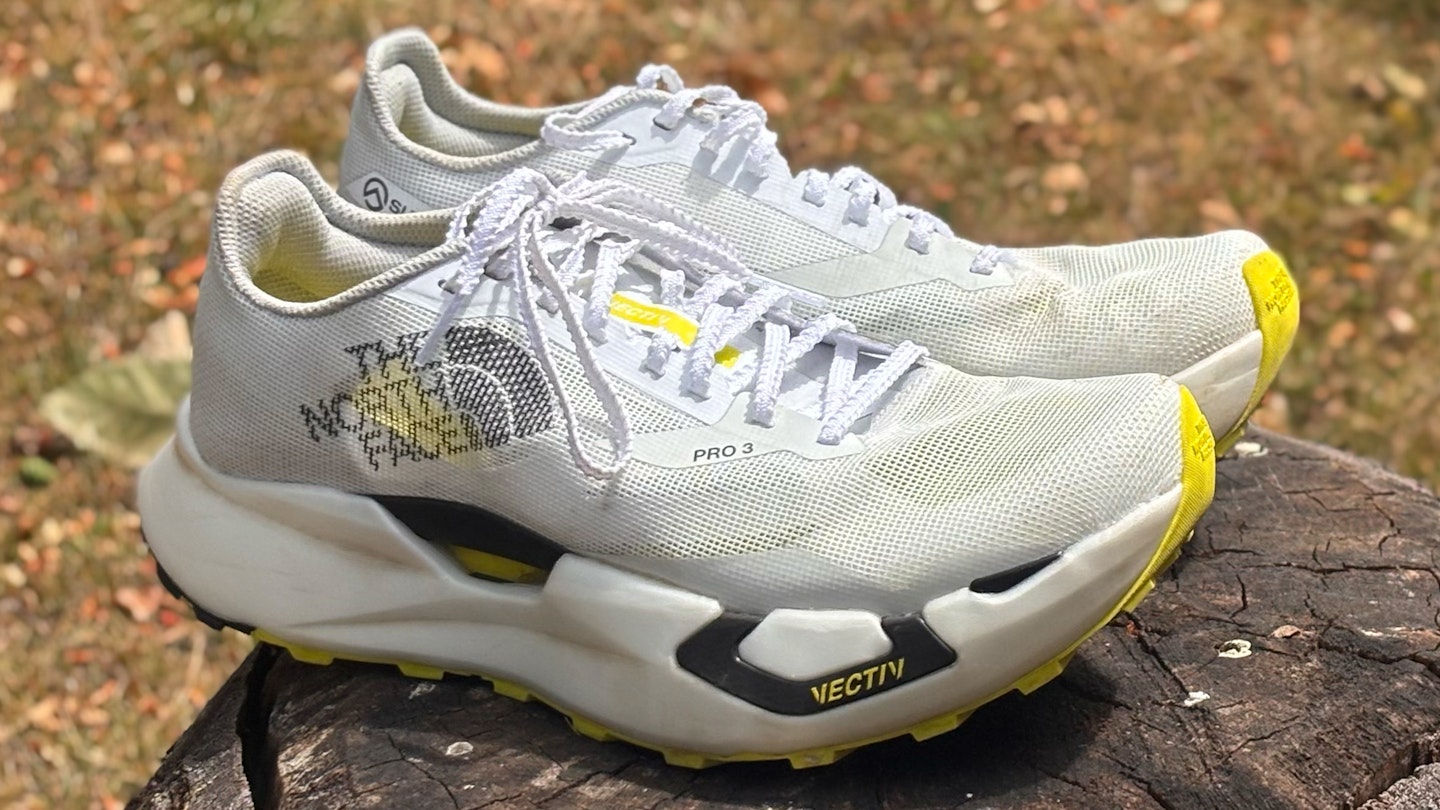
For the third time in a row, the upper of the Vectiv Pro shoe has been completely overhauled, and this particular overhaul is one that I endorse with both thumbs.
This time around, The North Face has found a sweet spot between the stiff, plasticky mesh of the original and the worryingly fragile-feeling material used on the Pro 2. The upper on the Vectiv Pro 3 feels soft to the touch, but also reassuringly robust.
It’s not Matryx, as seen on something like the Merrell MTL Long Sky 2, but it has a similarly dense, structured weave – non-stretch, highly breathable, and clearly built for long-term durability without sacrificing airflow.
Unlike most trail shoes, which reinforce their uppers with visible TPU overlays, the Vectiv Pro 3 hides its reinforcement on the inside. There’s an internal support frame that runs through the upper like a chassis, helping it hold its shape even when it’s not on your foot.
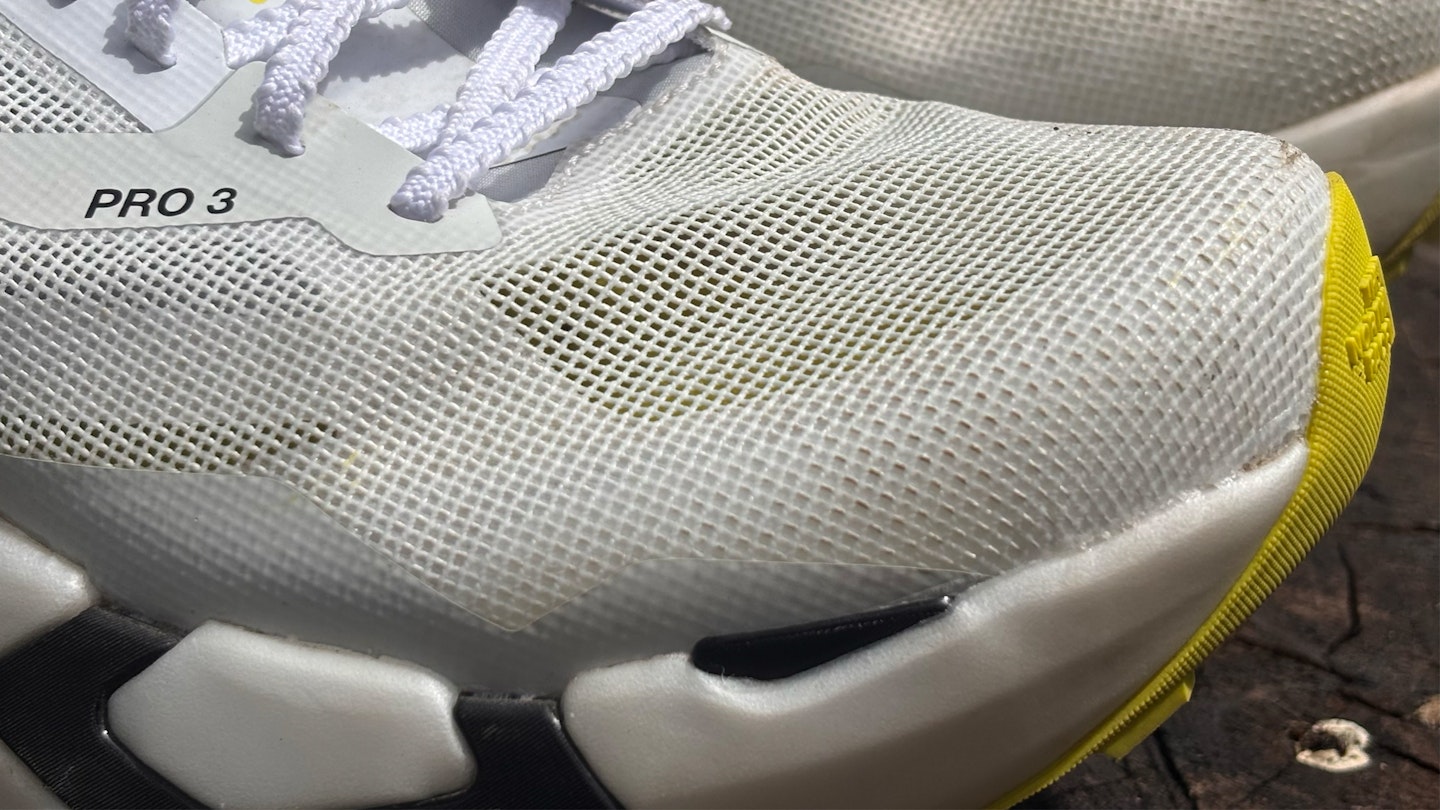
That internal structure culminates in a stiff, well-protected toe box that borrows a bit of rubber from the outsole for added impact protection – though this only applies to the dead centre of the toebox. So, if you're gonna kick a rock, make sure to give it a direct punt.
Around the heel, the collar sits a little lower than previous versions and includes a wraparound foam pod that hugs the upper heel. It doesn’t run all the way down to the midsole, so the lockdown relies partly on fit and lacing.
Luckily, The North Face continues to use its excellent textured laces which, as I've said many times here on LFTO, are my favourite laces on any running shoe. The ridged, high-friction surface means each eyelet holds tension perfectly, letting you dial in a precise, even fit without needing to maintain tension as you lace up.
The gusseted tongue is thinner than before and features large ventilation holes throughout the gusset and the tongue itself. It’s soft, minimal, and lightly padded at the top, though certainly not plush. There’s already some fraying on the edges of mine, so that’s worth watching, but elsewhere the upper has held up well, with no signs of wear after multiple long outings.
Midsole
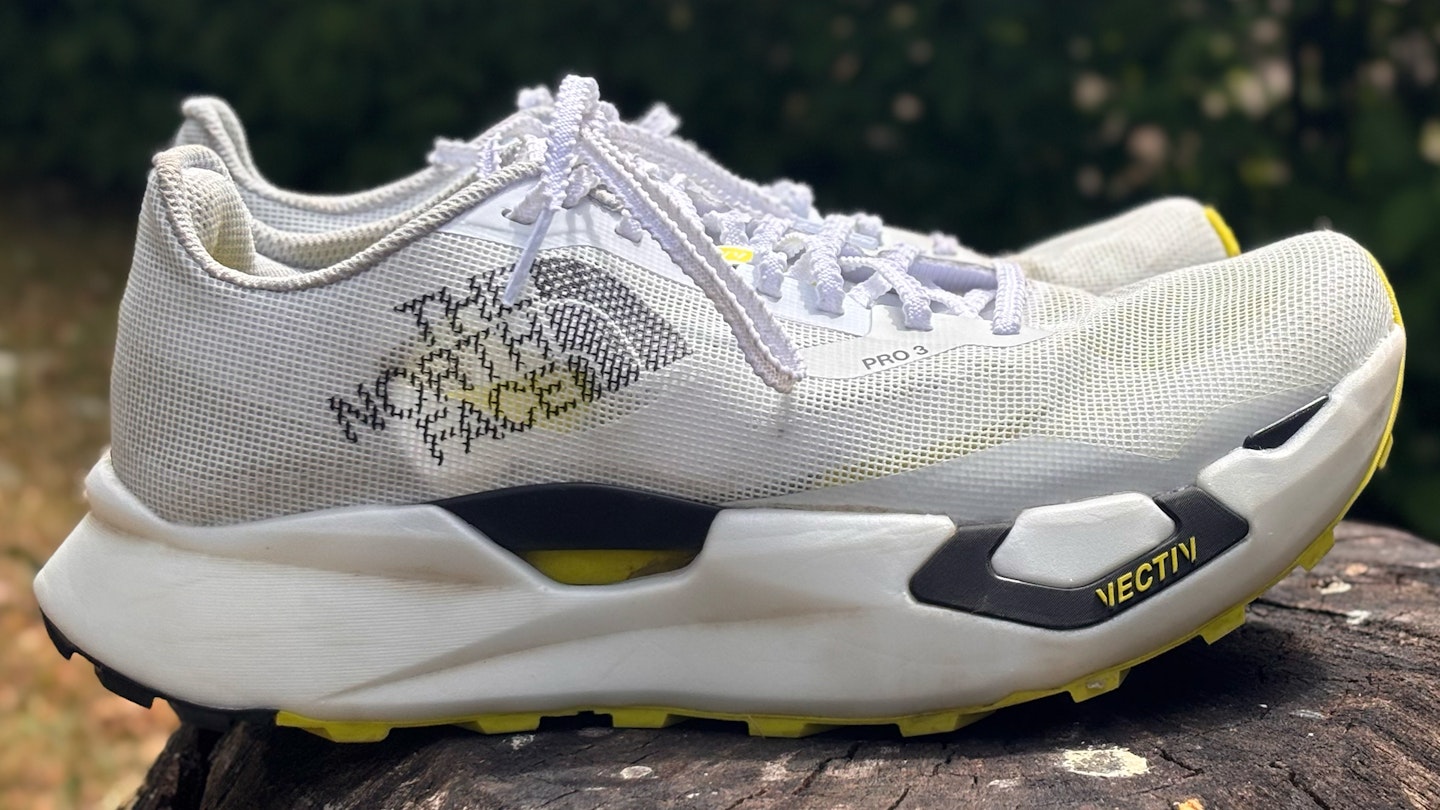
The midsole is where you'll first spot the most dramatic change in the Vectiv Pro 3 – at least visually. That towering stack height is hard to miss. But despite the exaggerated shape, the actual rocker geometry underneath your foot hasn’t changed much, which I’m happy to report was the right decision.
Like its predecessors, the Pro 3 feels more comfortable in motion than at rest. The sculpted rocker is designed to ease your stride forward, helping you transition smoothly from heel or midfoot strike through to toe-off.
Everyone – including The North Face – describes this sensation as “highly propulsive,” but that’s not quite accurate. The rocker doesn’t generate propulsion in the way a spring would; it simply reduces energy loss during each stride, helping you maintain momentum with less effort.
Still, whatever the technicalities, the shoe does feel propulsive. And a big part of that is down to the carbon fibre plate. In previous versions, it did double duty – adding forward snap and also flaring wide at the heel and forefoot for a bit of lateral stability. The Pro 3 takes a more modular approach.

Now, the carbon plate is all about speed, while a new plate (a flexible TPU insert just beneath the foot) handles stability. This split-role setup makes perfect sense for a shoe with such a tall stack and soft foam. You need a wide and fairly stiff footbed if you're gonna reduce underfoot ground-feel by this much.
The midsole's foam is a PEBA/EVA blend that The North Face calls Dream – lightweight, cushioned, and, yes, almost cloud-like in its springiness. I was paid £500 extra to write that.
It is genuinely the softest and bounciest underfoot feel I’ve experienced from any The North Face trail shoe. Almost too soft, perhaps – especially near the outsole, where the airy feel had me slightly concerned about long-term durability on sharp terrain.
That said, the wide platform and firm lateral stiffness keep the ride feeling secure. It’s got plenty of heel-to-toe flex for a smooth roll-through, but very little torsional twist, which helps offset the towering stack and gives the shoe a grounded, stable feel – despite its maximalist ambitions.
Outsole
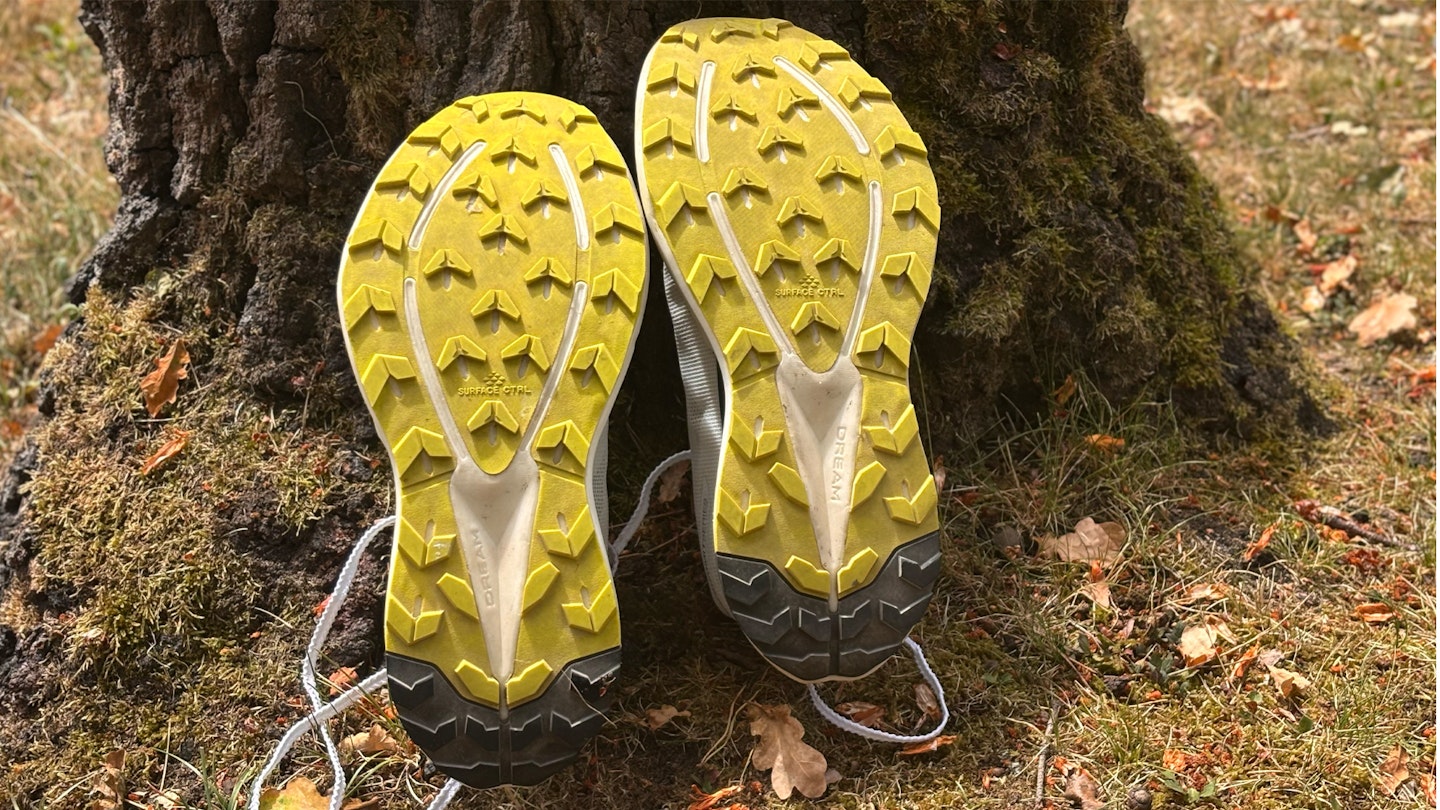
The outsole is made from the same SURFACE CTRL rubber used across most of The North Face’s trail running range. This has been their proprietary compound for yonkers, with versatility being the key design goal – which makes sense, considering how widely it’s deployed.
After all, what do you really need in an outsole? Grip, durability, and for the thing to not be too damn heavy. That’s the holy trinity, and SURFACE CTRL sits pretty squarely in the middle of all three.
If there’s a trade-off, it’s on weight. This isn’t the lightest rubber going, which contributes to the Vectiv Pro 3 being noticeably heavier than its predecessors – though the extra foam and additional plate in the midsole are also to blame.
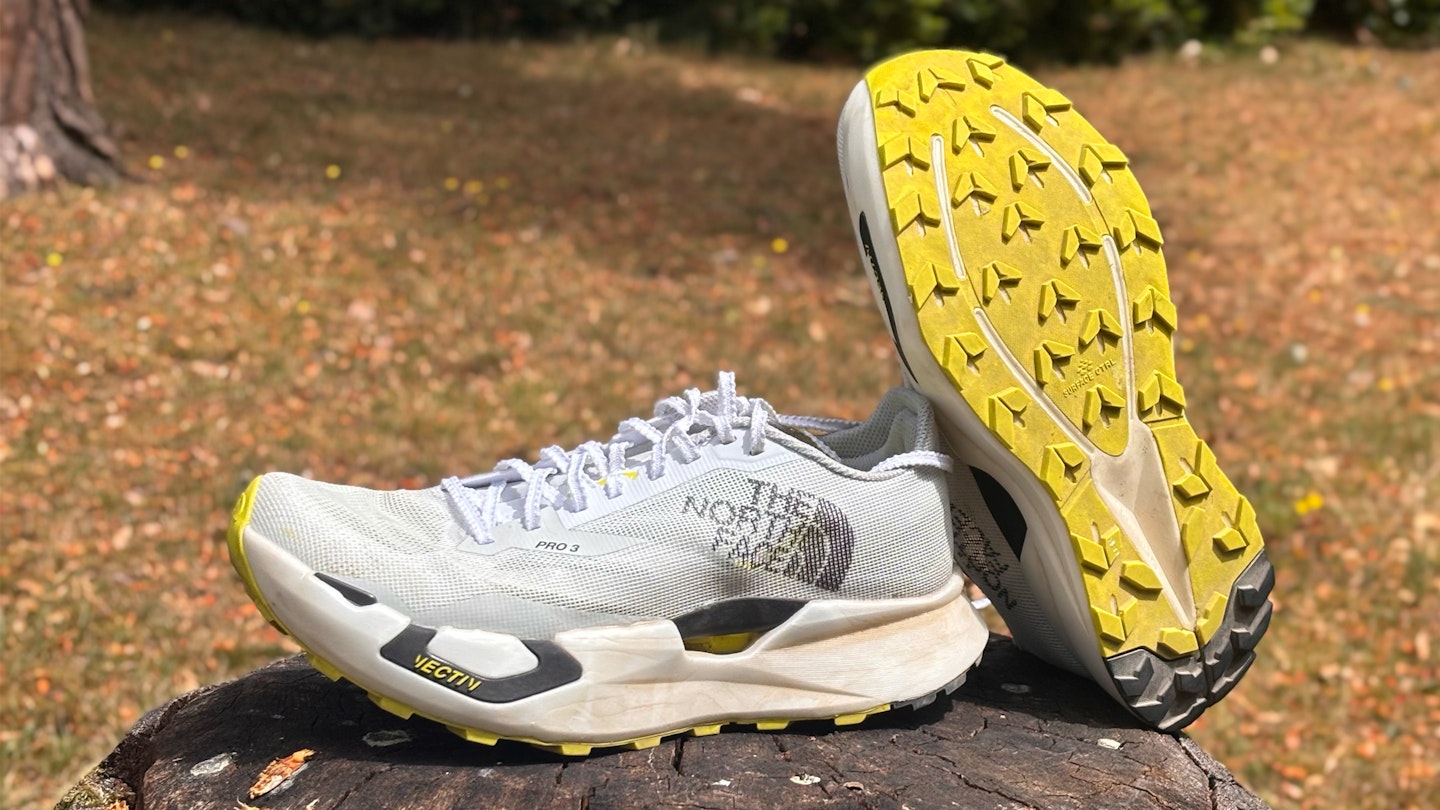
TNF makes some sustainability claims here – namely that 20% of the rubber is sourced from smallholder farmers using agroforestry and regenerative practices. That’s vague but promising. Still, let’s be honest: this is a 100% synthetic shoe, and not one that’s going to earn many eco points on materials alone.
Where it might claw some back is in longevity. If it’s built to last, that’s fewer replacements down the line – and the Vectiv Pro 3 does feel built to last.
The lugs are technically the same length as those on the Pro 1 and 2, but they feel far more aggressive thanks to their sharp, angular shape. You get large, forward-facing chevrons across the mid- and forefoot, with blockier, rear-facing ones under the heel.
The wider lug profile also means wider spacing, which opens up a bit of mud channeling – though in my experience, they don’t really shed the stuff as cleanly as I’d like.
The rubber itself has a grippy, rough texture that gives great traction on dry trail and stone – but it’s equally great at helping wet mud hitch a ride home on your outsole. Watch your carpets.
In fairness, this has never claimed to be a soft-ground shoe. It’s a versatile outsole, but far better suited to summer runs and hard-packed terrain.
Price and competition

The Summit Vectiv Pro 3 lands at a steep RRP of £225, putting it squarely in premium territory. But, in fairness, it’s not really playing the same game as most trail shoes.
While other cushioned models like the Hoka Speedgoat 6 and Asics Trabuco Max 4 offer plush midsoles and versatile outsoles for considerably less dosh, neither of them features a carbon plate, nor are they quite as tailored toward racing.
The Trabuco Max 4, in particular, was our top pick for road-to-trail running shoes this year, offering an ultra-cushioned ride at a far more accessible price – but it's heavier and slower off the mark when you’re trying to move fast.
Ultimately, it’s very hard to find a trail running shoe with this much cushioning that’s also geared for speed, and that’s where the Vectiv Pro 3 justifies its own little category. With its carbon plate and mega soft midsole, it's positioned as the rare breed of shoe that can handle ultra-distance racing without sacrificing comfort, making it a serious consideration if you're the kind of runner who wants to go far, fast, and often.
Verdict
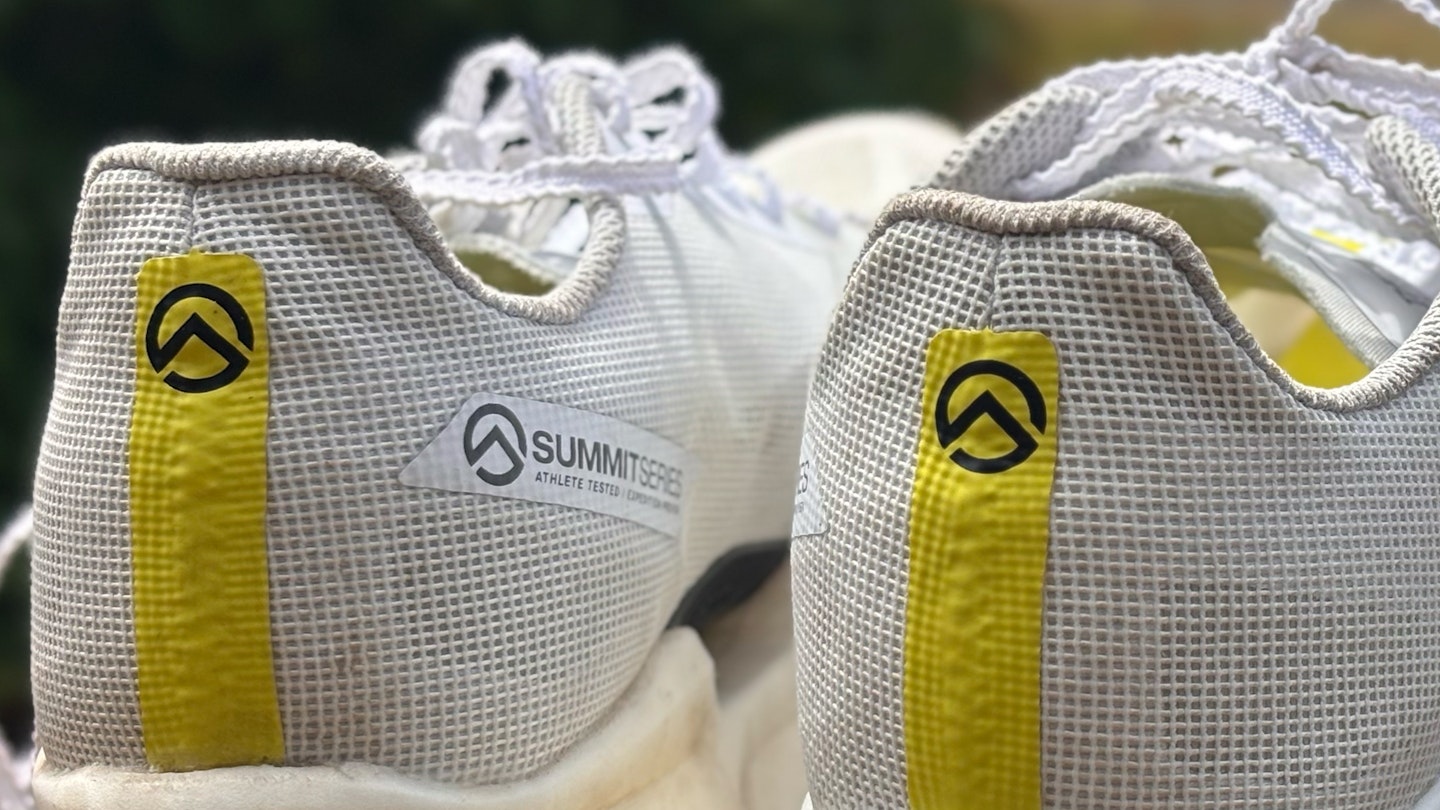
A shoe for serious trail runners which is reflected in both performance and price. The North Face Vectiv Pro 3 is leaps and bounds ahead of its predecessors, to the point where we may even call it over-engineered. But if you're looking for a fast shoe with a high stack and versatile outsole, there's nothing better.
For more options that can handle long distances, check out our roundup of the best ultra trail running shoes.
Shop this product
About the author
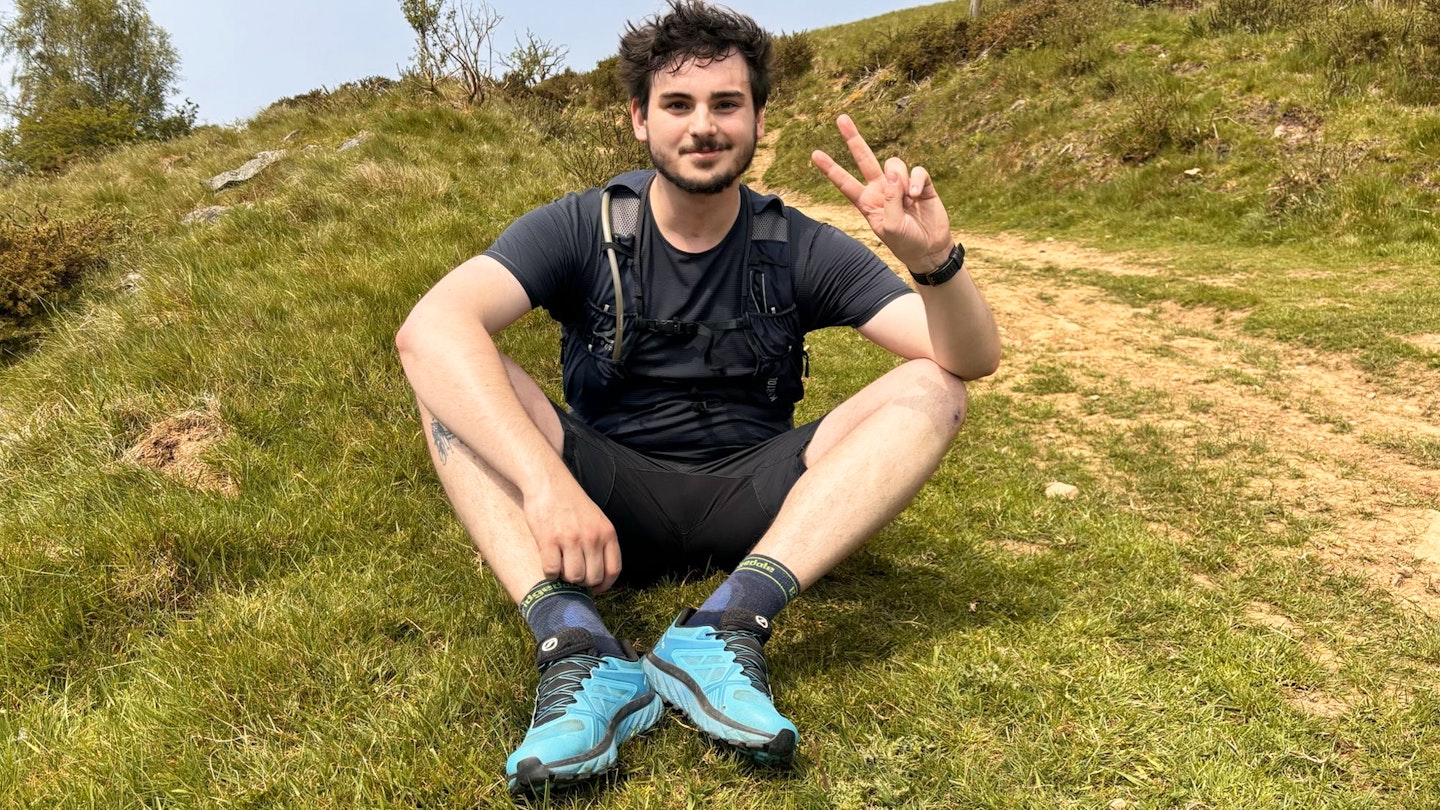
Milo Wilson is our full-time trail running tester and writer at LFTO. He's served loyally here for over two years, having finally found a stable home after far too much freelance writing. Milo spends his weekends lolloping around the Surrey Hills like a wounded gazelle – often filming his exploits to promote our #Run1000Miles Challenge.
